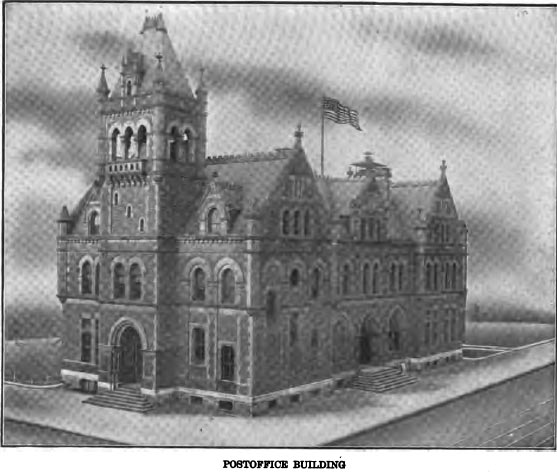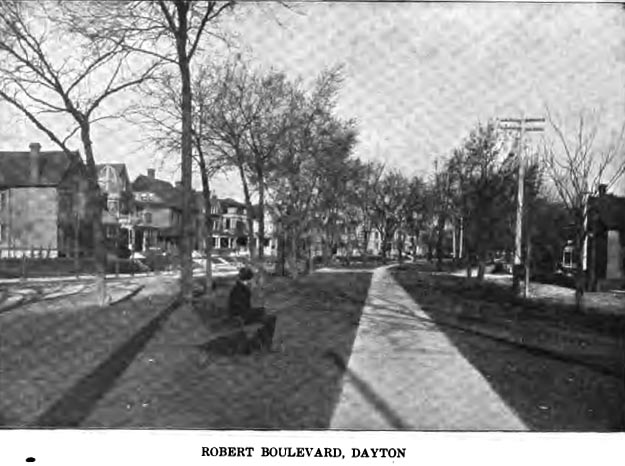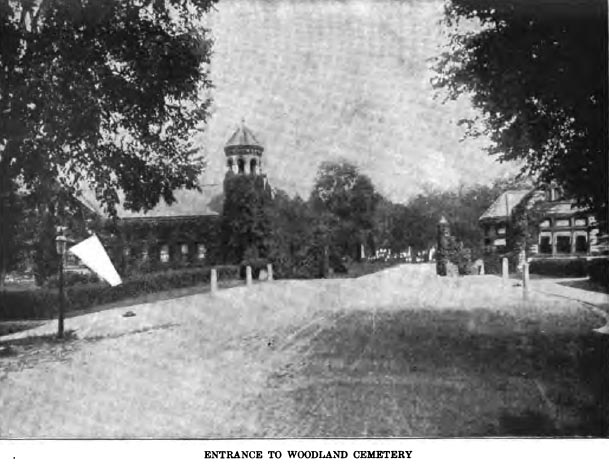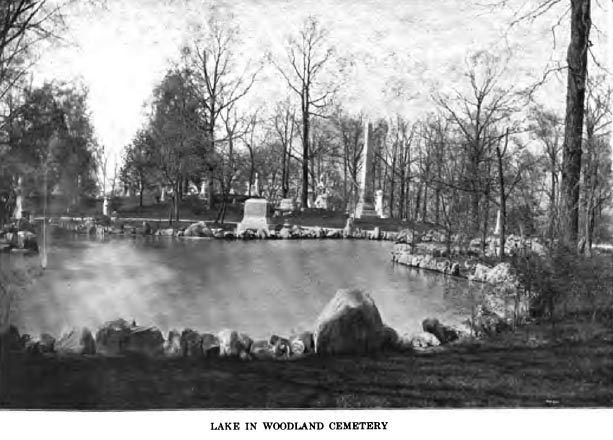PARKS
Cooper Park is a just memorial to the
public spirit of the founders of the city. Though
small, it is of incalcuable value situated as it is in
the very heart of the city. In 1896, Dayton’s
centennial year, Van Cleve Park, furnishing a site for
the old log cabin, was added. It is small but,
situated on the bank of the river as it is, is of value
out of all proportion to its size. In the center
of the city, the wide streets and the open dooryards
with their beauty and adornments serve in part the
purposes of parks. In the southern part of the
city Park street, in Riverdale the Great Miami
boulevard, in the eastern part of the city Findlay Park,
are examples of breathing places and beauty spots in
what a few years ago were the outskirts of the city.
Robert boulevard and the levees are well deserving of
mention. The Fair Grounds and the Soldiers’ Home
have all the advantages for Dayton as city parks.
Hills and Dales, south of Dayton, if the public should
be so fortunate as to secure it, has the finest
possibilities for park purposes.
Areas for parks in various directions from the city are
being considered. The park commission, as provided
for by act of the legislature and approved by the people
at the recent election, will, it is hoped, bring order
out of confusion and secure for Dayton the system of
parks so necessary to the health and enjoyment of the
people and the beauty and prestige of the city.
POST
OFFICE
The history of
the Dayton postoffice is a record of continuous growth,
of marvelous development. Established in 1804,
when the postal service of the United States was in its
infancy, and when the territory northwest of the Ohio
river was for the most part a wilderness, with
settlements remote from each other, and far removed from
the populous centers along the Atlantic seaboard, the
Dayton postoffice necessarily had a small beginning.
It was located in a cabin at the southeast corner of
First and St. Clair streets, and all the mail which
arrived at or departed from it was carried by a post
rider, who visited it only once in two
[Pg. 582]
weeks. Its facilities, though of vast importance
to the pioneers, were no more like those of the
postoffice of today than the few log cabins scattered
along the south bank of the Miami were like the present
magnificent city of Dayton, with its one hundred and
twenty-five or thirty thousand population, enjoying all
the conveniences that modern ingenuity has been able to
devise and all the luxuries that wealth will supply.
The first postoffice was in harmony with the times and
its surroundings. It was a great boon to the
settlers, for it supplied the means of communication
with friends and relatives at distant points and was of
decided benefit in the transaction of business.
Doubtless its limited facilities were as highly
appreciated as is the superb postal service of today,
when one hundred mails arrive and one hundred and two
depart daily from the postoffice, and incoming mail is
delivered by carrier at the doors of patrons from two to
four times each day, while outgoing mail is repeatedly
collected, both day and night, from hundreds of street
letter boxes placed at convenient locations throughout
the city.
[Pg. 583]

POST OFFICE BUILDING
[Pg. 584] - (blank page)
[Pg. 585]
COMPARATIVE STATEMENT OF BUSINESS OF
VARIOUS DEPARTMENTS OF THE POSTOFFICE DURING TEN YEARS,
JUNE 30, 1899 TO JUNE 30, 1909.
RECEIPTS.
1899
...........................................................
$213,390.14
1909
...........................................................
508,015.96
Percentage of increase 138.
MONEY ORDER DIVISION.
1899
............................................................
$22,654 $118,330
1909
............................................................
46,819 217,482
Percentage of increase 105.
[Pg 586] -
REGISGRY DIVISION
1899 - letters, etc., registered
...................... 7,148
1909 - letters, etc., registered ......................
44,727
Percentage of increase
525.
MAILING DIVISION.
[Pg 587] -
institution. It soon outgrew these quarters,
however, and more commodious rooms became a necessity.
In 1869 Postmaster William M. Green removed the
office to the southwest corner of Fourth and Jefferson
streets, where it occupied the lower floor of the United
Presbyterian church building. To make this
structure suitable for the accommodation of the
postoffice it was lifted off its foundation and raised
six or eight feet. New brick walls were then run
up from the foundation to connect with the old ones,
the effect being to convert the basement of the old
church into rooms with high ceilings and to lace the
floor, which had previously been below the surrounding
surface, on an elevation slightly above the sidewalk.
This was an interesting operation to the inhabitants of
Dayton, for it was the first time that a brick building
in this city had been raised in that manner, and it
attracted attention because of its novelty. The
building, greatly, altered in appearance, and no longer
used as a place of worship still stands.
PORT OF ENTRY.
July 1, 1904, the
office of the Dayton Port of Entry was opened. In
1908,
Edward L. McConnaughey succeeded Oscar I. Robbins
as surveyor. The latter had served as
surveyor from the opening of the port. the
receipts of the local office for the year ending June
30, 1909, were one hundred thirty-six thousand, six
hundred four dollars and seventy-eight cents. The
cost of maintaining the office was about three per cent
of the total receipts. Dayton ahs the advantage of
having a first class bonded warehouse where goods may be
held for later delivery. Goods on which forty
thousand dollars in duties are payable were stored in
the warehouse in November, 1909. Among the ports
of the state of Ohio the Dayton port holds a place next
to those of Cleveland and Cincinnati.
DAYTON STATE HOSPITAL.
In 1851, the
asylum at Columbus was the only one in the state and was
known as the Ohio Lunatic Asylum. Its capacity was
three hundred patients. The superintendent of the
asylum at that time, Prof. S. M. Smith, estimated
the insane in the state that year at two thousand.
[Pg 588] -
As a result of the recommendations of Dr. Smith
and others, the following winter the legislature passed
an act dated Apr. 30, 1852, entitled: "An act to provide
for the erection of two additional lunatic asylums."
Prof. H. A. Ackley, E. B. Fee, D. B. Woods, Charles
Cist and Edwin Smith, composed the board
appointed under the act. The legislature made an
appropriation of one hundred and forty thousand dollars,
for the purpose of building the two asylums.
On the 7th of July, 1852, the board met in Cincinnati
and on the 8th at Dayton, and agreed not to locate
either of the two asylums at any point, unless fifty
acres of land were donated for the purpose. On the
9th of July, it was voted to locate one at Newburgh, now
a part of Cleveland and the next day Dayton was selected
as the other site. September 1st, a site was
selected at the foot of Wayne avenue and September 6th
the county commissioners appropriated five hundred
dollars toward paying for the land, the balance of the
purchase money being donated by the citizens.
The original contract was let for sixty-seven thousand,
three hundred fifty dollars and fifty cents.
Besides the money expended in payment of architects,
superintendents, et cetera, the entire cost amounted to
about one hundred and ten thousand dollars.
June 22, 1854, Joseph Clements, M. D., was
appointed superintendent, the institution opening
September, 1855. In his first report, he says:
“Very little has been done toward grading the grounds;
no library, eight iron bedsteads, no smoke house or ice
house.” The current expenses were four thousand,
nine hundred dollars and fifty-two cents, and the number
of patients fifty-nine. In April, 1856, the
institution was re-organized and Dr. J. J. McIlheney
was appointed superintendent. The number of
patients at one time in the institution was one hundred
and thirty-three. For several years, the roll
gradually increased. By 1865, it reached one
hundred and seventy-one. The following year an
appropriation of forty thousand dollars was made for new
wings. Additional money was later added, making a
total of two hundred and ninety thousand dollars and in
1869, the additions to the building were occupied.
By 1872, the daily average of patients was six hundred
and nine.
Other additions have since been made and all portions
equipped in first-class manner.
The names under which the institution ahs operated are
as follows: 1855, Southern Ohio Lunatic Asylum;
1875, Western Ohio Hospital for the Insane; 1877, Dayton
Hospital for the Insane; 1878, Dayton asylum for the
Insane; 1894, Dayton State Hospital.
The staff in control is most efficient and has been
ably directed by Dr. A. F. Shepherd for nearly
eight years.
The location is most excellent being in the extreme
southeastern orton of the city. The hosital has a
frontage of nine hundred and forty feet.
The institution proper stands in a beautiful grove
broken and varied with well kept lawns, three lakes and
flower plots. The view of the surrounding country
from teh high land on which the institution is located
cannot be surpassed by any location in Dayton and
vicinity.
Many improvements have been made during the term of the
resent superintendent. The hospital has an
excellent water supply furnished by water works.

ROBERT BOULEVARD, DAYTON
[Pg. 590] - blank page
[Pg. 591]
connected with the institution. The water is
brought from wells dug about a mile from the main
building.
A number of recent buildings include a power house,
electrical plant, new horse barn, dairy barn and
laundry.
Outside of the main building a number of cottages have
been built, including an infirm cottage for men and
another for women, each having two wings, a convalescent
cottage for women, and a cottage for working men.
On Nov. 2, 1909, five hundred and ninety-five women and
six hundred and four men were registered inmates of the
hospital. Four assistants, three male and one
female and about eighty attendants comprise the staff
which with the superintendents, look after the interests
of the inmates.
Mr. E. M. Garrett, the steward, has the general
financial management of the institution.
The grounds immediately connected with the hospital
amount to one hundred ninety and one-half acres.
In 1909, additional lands amounting to five hundred
seventy-six and one-half acres were purchased, the same
being a part of the Shaker farm and being
situated east of the hospital buildings, about three
miles lying immediately west of the Greene county line,
the purchase price being eighty thousand dollars.
For the present this land will be largely used for
farming purposes. It will later be made to serve
other purposes connected with the hospital, but the
buildings and improvements on the present site will be
used as heretofore.
The superintendents and their time of appointments are
as follows: Dr. Joseph Clements, 1854;
Dr. J. J. McIlhenny, 1856; Dr. Richard Gundry,
1862; Dr. S. I. F. Miller, 1872; Dr. Rutter
(acting superintendent), 1873; Dr. Clark 1874;
Dr. L. R. Landfear, 1876; Dr. D. A. Morse,
1878; Dr. H. A. Tobey, 1881; Dr. C. W. King,
1884; Dr. Calvin Pollock, 1888; Dr. C. W. King,
1891; J. A. Rompert, 1892; Dr. J. M.
Ratliff, 1894; Dr. A. F. Shepherd, 1902.
THE ASSOCIATED CHARITIES.
The Associated
Charities of Dayton was organized at a meeting of
representative citizens, held in the Grand Opera House,
on Dec. 20, 1896. Two
[Pg. 592]
[Pg. 593]
WIDOWS' HOME
When the Woman's Christian
Association was organized in 1870, it was incorporated
under the name "The Woman's Christian Association of
Dayton, Ohio, for the support of widows and destitute
women" in order that it might receive the property of
the old Dayton Female Orphan Asylum on Magnolia street,
which by an act of the legislature was transferable to
any institution providing for the care of destitute
women. This transfer was made in 1872, and after
repairs, the house was open for the reception of
inmates, Feb. 8, 1875. Mrs. A. L. Connelly
was the first matron of the home. For the past
twenty years the matron has been Miss H. S. Nease.
The hill on which the Magnolia street home was
located has borne the name of "Charity Hill." The
firt city hospital was located here and the city
in-
[Pg. 594]
firmary had a location adjacent. On this hill at
the present time is located the magnificent Miami Valley
Hospital.
The Widows' Home, now located on Findlay street, is
under the superintendence of a committee appointed by
the board of managers of the Woman's Christian
Association. A two-thirds vote of the committee is
required for admittance to the home.
Any widow or destitute woman of good moral character
over sixty years of age who has resided in Dayton five
years can become a permanent inmate by the payment of
one hundred dollars to the endowment fund, furnishing
her own room and clothing, and paying fifty dollars for
funeral expenses.
The home receives additional support through gifts of
money and donations from the various churches and an
annual harvest home donation from the people of Dayton.
The twenty-four old ladies residing in the home are
faithfully cared for through the services of the matron,
a physician and nurse.
ST. JOSEPH ORPHANAGE
The organization of St. Joseph
Orphanage dates back to the time of the cholera plague
in 1849, when many children, belonging to the poorer
population were orphaned. In September of that
year, a number of Catholic gentlemen founded the home on
a small scale with the intention that it should meet
only temporary conditions. In 1891, it was placed
under the direction of the Sisters of the Precious
Blood. In 1899, the increasing number of children
necessitated the addition of an east wing and a chapel
to their home, located on the east side of St. Paul
avenue, between Xenia avenue and Wyoming street.
In 1904 the establishment was enlarged to the present
large and commodious structure. In 1908, a
hospital for the treatment of contagious diseases among
the children was erected. There are ninety-two
boys and girls in the home. The moral, religious
and industrial training of the children is carefully
managed, with Sister M. Electra as the superior.
The society which fosters the home has a membership of
eight hundred. Frank J. Hegman is the
president. Rev. Peter Schirack is the
chaplain.
FLOWER AND FRUIT MISSION
[Pg. 595]

[Pg. 596] - blank page
[Pg. 597]
For the sake of poor, tired and sick mothers, and
children, who need the pure air of the country, as well
as the good substantial care of such a home with
nourishing food, a fresh air branch of the mission was
added three years ago. A farm near the village of
Bellbrook, was recently purchased and a new dormitory
with the capacity of thirty beds, was built at a cost of
thirty-three hundred dollars.
The number of churches that cooperate with the officers
and directors of the mission, is fourteen. The
officers are: Honorary President, Miss Emily Stewart;
President, Mrs. G. Harries Gorman; First
Vice-President, Mrs. Harry G. Carnell; Second
Vice-President, Mrs. Allen E. Thomas; Third
Vice-President, Miss Minnie B. Conover; Secretary
and Treasurer, Miss Florence D. Evans.
DOOR OF HOPE
CEMETERIES
WOODLAND CEMETERY.
The first "graveyard" of Dayton was located at the
northeast corner of Main and Third streets. Mr.
D. C. Cooper, the proprietor of the town, gave the
lots one hundred and thirty-three and one hundred and
[Pg. 598]
thirty-four on his plat to the Presbyterian church, and
as it was the custom in that day to connect the
graveyard with the church, the ground was also used for
burial purposes. It was soon manifest that these
lots would be encroached on by the town, and, in 1805,
Mr. Cooper donated to the Presbyterian and
Methodist churches and to the town, as a burying place
for strangers, four acres of ground on the south side of
Fifty street, between Ludlow and Perry streets, each to
have equal parts.
The location was thought to be so remote from the town
that it would never be encroached upon. In less
than thirty years it was found to be unsuitable for the
purpose and at length, cemeteries having been
established elsewhere, interments were forbidden in it
by city ordinance.
Later the reversionary interest of the Cooper heirs
having been purchased the ground was laid out in
building lots and sold, bringing a handsome sum to the
churches and to the city. The remains of the dead
were carefully disinterred and reburied in Woodland
cemetery.
In 1840, a movement was made to establish a rural
cemetery, where every possible safeguard should be
thrown about the resting place of the dead. Mr.
John W. Van Cleve made the suggestion and was most
active in promoting the object. To him more than
any other the city is indebted for the beautiful
cemetery and for the property which has attended the
enterprise from the beginning. He and Samuel
Forrer, both capable engineers, lent their skill to
the laying out of the grounds. At his death in
1858 the trustees expressed their sense of obligation to
him in a memorial recorded in the minutes of the
association.
Articles of association were drawn up by Mr. Van
Cleve and fifty-two subscribers obtained. Each
subscriber agreed to pay into the treasury one hundred
dollars to be repaid to him without interest either in
burial lots or in money, when the affairs of the
association justified. In a short time the claims
of the subscribers were liquidated, the majority of them
taking lots in payment.
MORE TO COME
[Pg. 599]

LAKE IN WOODLAND CEMETERY
[Pg. 600] - blank page
[Pg. 601]
[Pg. 602]
CALVARY CEMETERY.
The first burying ground of the Catholics of Dayton,
bore the name of St. Henry's cemetery. In
September, 1844, one-half of out-lot No. 27, was
purchased by Archbishop Purcell of Thomas
Morrison, for three hundred and five dollars.
Mar. 2, 1853, the south of the same lot was purchased of
E. W. Davies, for eight hundred dollars.
These two pieces of ground constituted St. Henry's
cemetery. This was the only burying place for
Catholics for many years, and by 1872, had became so
crowded as to lead to the establishment of Calvary
cemetery.
On the 9th of July, 1872, Calvary Cemetery Association
was organized by the election of the following board of
trustees: Revs. J. F. Hahne, William M.
Helfrich, N. Ohmer, John Stephans and Henery
Hilgefort for two years; and Robert Chambers,
Severin Wiegert, Theodore Barlow and Henry
Schlaman, for one year; Secretary Jacob Stephans.
Ninety acres of ground were
purchased and twenty-seven and one-half acres were added
later, making one hundred and seventeen and one half
acres located ........ MORE TO COME
[Pg. 603]
JEWISH CEMETERIES.
The congregation B'nai Yeshurun on Jefferson street
acquired in 1848 for cemetery purposes a small lot of
ground on South Brown acquired in 1848 for cemetery
purposes a small plot of ground on South Brown street,
near where the National Cash Register Company now is.
About 1890 this cemetery was nearly filled, and was
being surrounded by dwellings. The congregation
then purchased seven acres on the hill south of the
city. Under the direction of Mr. Adam Lessner,
the grounds were beautifully laid out. The
cemetery is called the Riverview cemetery.
The Wayne avenue congregation (House of Abraham)
purchased a small strip adjoining the Riverview
cemetery, about 1903.
The cemetery of the Wyoming street congregation (House
of Jacob), is about four miles north of the city on the
Troy Pike.
SOLDIERS' MONUMENT
[Pg. 604]
[Pg. 605]
[Pg. 606]
[Pg. 607]
[Pg. 608]
<
CLICK HERE to RETURN to TABLE of CONTENTS
> |